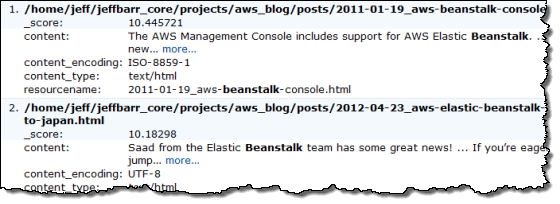

Usually, users are required to define a shared mount path. In Elasticsearch, data is backed up (and restored) using the Snapshot and Restore module. Data can also be pushed to S3, with the data path given to index the documents. In Amazon CloudSearch, data and documents (in either XML or JSON format) are pushed in batches. Some of the recently developed input_changes are couchdb_changes, Twitter, and rabbitmq. Recently, Logstash and input_changes plugins have taken center stage to replace rivers as tools to push data to Elasticsearch, too. This makes them available for searching logs or to plot graphs in Kibana. Logstash Forwarders, are normally used to push logs from application or database servers to Elasticsearch. However, for various reasons, river plugins are being deprecated.

There are many popular river plugins available such as elasticsearch–river- mongodb, elasticsearch-river-couchdb, Elasticsearch-jdbc. In Elasticsearch, there are plugins called “rivers” to push data into a cluster. When existing data need to be searchable, they should be imported to the search engines. However, this can result in delayed upgrades of new releases, though with delay comes stability. Updates of Amazon CloudSearch are pushed by AWS, relieving users of the responsibility. The process can be as easy as replacing the lib folder of an older version with a new version. CloudSearch: UpgradingĮlasticsearch is easy to upgrade. Users are able to select High-Availability (AZ level), replication, and partitioning options through the AWS Management Console or AWS CLI. However, Elasticsearch is an independent product developed by, which means you can set up Elasticsearch independently by downloading and extracting the tarball, or through a yum/apt-get install.Īmazon CloudSearch, on the other hand, is fully managed by AWS, which, once you choose your instance type, handles the complete provisioning. CloudSearch: Provisioningīoth Elasticsearch and CloudSearch are provided by Amazon as AWS services. We’ll explore the battle of the Amazon search providers: Elasticsearch vs. However, there are also other popular players in the search engine market, and Elasticsearch ranks right behind Solr as the most popular search and analytics engine. AWS CloudSearch is certainly a powerful and appealing service from Amazon. In part one of this series, we described what search engines are, how they solve the problem of accessing content stretched across large websites, and how Amazon CloudSearch provides a solution for a cloud environment. Want to jump-start your learning on search engines and analytics in general? Get some direct Elastisearch knowledge in our Analytics Fundamentals for AWS course: While both services use proven technologies, Elasticsearch is more popular, open source, and has a flexible API to use for customization in comparison, CloudSearch is fully managed and benefits from managed service features such as (near) plug-and-play startup and auto-patching and updating. Let’s compare AWS-based cloud tools: Elasticsearch vs.


 0 kommentar(er)
0 kommentar(er)
